Ask a number of individuals to explain the toe-to-bar motion and also you’re more likely to hear a number of descriptions of how the end result needs to be completed. That’s, truly getting one’s toes “to the bar.” You may assume the train was comparatively easy sufficient contemplating its self-evident title, however that’s like pondering there’s just one option to “squat.”
Whereas the motion has gymnastics roots, the toes-to-bar is carefully related to CrossFit athletes and the train options incessantly in WODs (exercises of the day). Regardless of the motion’s erratic look, the toes-to-bar has potential advantages for athletes of any sport, in addition to physique-focused bodybuilders. This text describes approach and programming concerns for the toes-to-bar.
Toes-to-Bar
The best way to Do the-Toes to-Bar Step By Step
A standard model of toes-to-bar entails well-coordinated motion of physique segments to attain quick and environment friendly efficiency —kipping. A variation entails action of your abdominals and hip flexors with immaculate physique management — strict. The kipping model is described under.
Step 1 — Seize the Bar
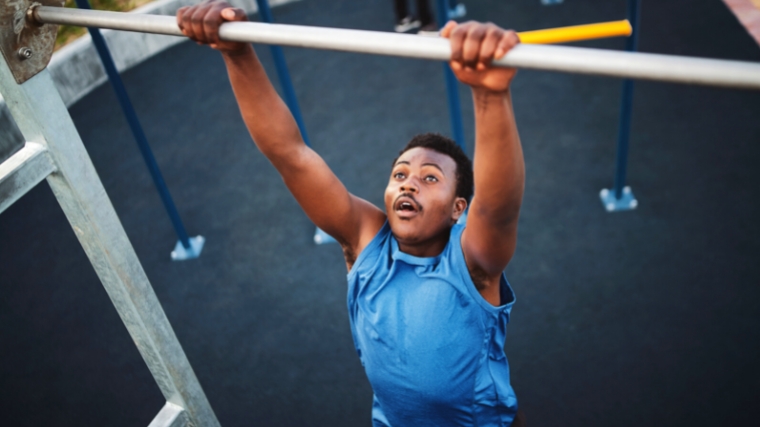
Select an applicable pull-up bar that’s robust, safe, and taller than your standing overhead-reach top. Take an overhand grip at, or barely outdoors, shoulder-width and grasp with straight arms.
Type Tip: Think about using a “reverse hook grip” — After wrapping your fingers across the bar, squeeze your thumb over the nailbed of your index finger (and center finger, too, should you’re ready).
Step 2 — Generate a Kip

“Kipping” refers back to the managed act of swinging to generate momentum. For the toes-to-bar, provoke the kip by arching your again as you extend your legs behind you. Your physique ought to type an prolonged or “arched” form underneath the bar. Instantly reverse the motion by rounding your backbone and pulling your legs ahead to attain a flexed or “hole” form underneath the bar. With out shedding velocity, transition once more to the preliminary prolonged form.
Type Tip: When kipping, it’s useful to consider pushing and pulling the bar horizontally though the bar itself gained’t transfer. First push backward, then pull ahead, after which push backward once more. This can assist to include your higher physique, enhance stability and positioning, and might help set up a rhythmic motion.
Step 3 — Carry the Kip into Upward Leg Motion

From the arched place, carry your trunk and leg momentum ahead as soon as once more, however this time actively flex your low again and hips on the finish of the kip to transition the momentum upward to the ceiling, not ahead.
Type Tip: Maintain your gaze straight as you elevate your toes. Following your toes along with your eyes will solely promote neck and backbone extension, which is able to intrude with this part of the motion.
Step 4 — Contact Your Toes to the Bar

As your low again and hips attain most flexion (i.e. most compression between your abdomen and thighs), straighten your knees and contact your toes to the bar. Use management — you don’t wish to kick the bar.
Type Tip: Rapidly “flicking” your knees into extension on the prime of the repetition relatively than maintaining your knees straight all through the motion will promote motion effectivity and velocity.
Step 5 — Return to the Prolonged Arch Place
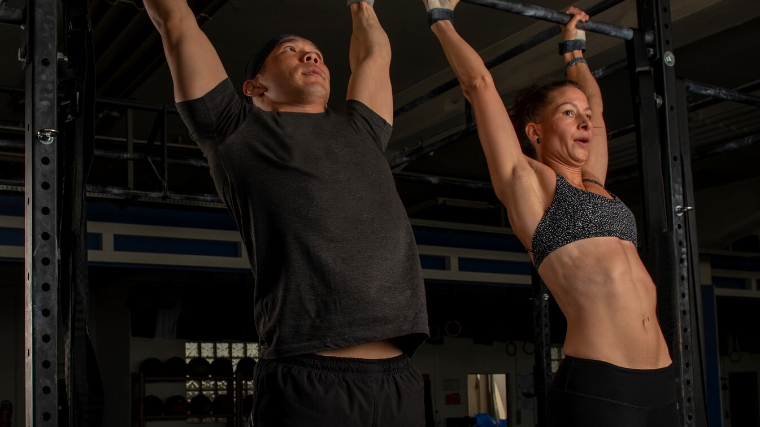
To easily transition into the following rep, enable a slight re-bend to your knees and drive your hips into extension downward. As your legs transfer under your waist, start to increase your backbone. When you obtain the arched place, instantly transition to the hole place to provoke the following repetition.
Type Tip: Not like the primary repetition, subsequent reps mustn’t require a number of ahead and again kipping actions to generate momentum. Transition instantly from the hole place into the upward leg movement of the following repetition.
Toes to Bar Errors to Keep away from
Frequent toes-to-bar errors happen when type will get sloppy, when vary of movement will get minimize quick, or when the excellence blurs between the kipping model and the strict model.
Swinging Too Far Ahead
An athlete who permits their hips to journey beneath the bar throughout the “hole” place (instantly earlier than and through the leg lift) is unlikely to attain a full repetition. Even when the repetition is salvaged, extreme swinging will disrupt the rhythm of the kip and intrude with the following repetition.
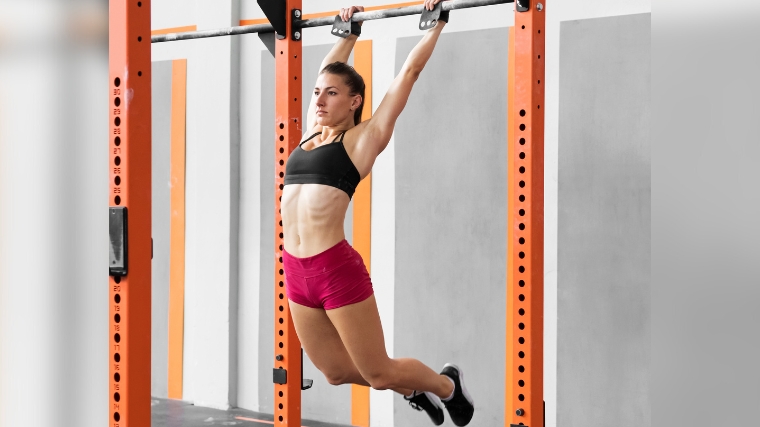
Keep away from it: When transitioning from the “arch” place to the “hole” place of the kip, keep away from extreme ahead movement of the pelvis by actively pushing your self backwards. Holding pressure in your higher physique and making an attempt to maneuver the bar might help.
Lacking Full Compression on the High
Attaining the top objective of touching your toes, effectively, to the bar requires full hip and low again flexion. Athletes who fail to attain this absolutely compressed place could merely require approach remediation or supplemental mobility work.
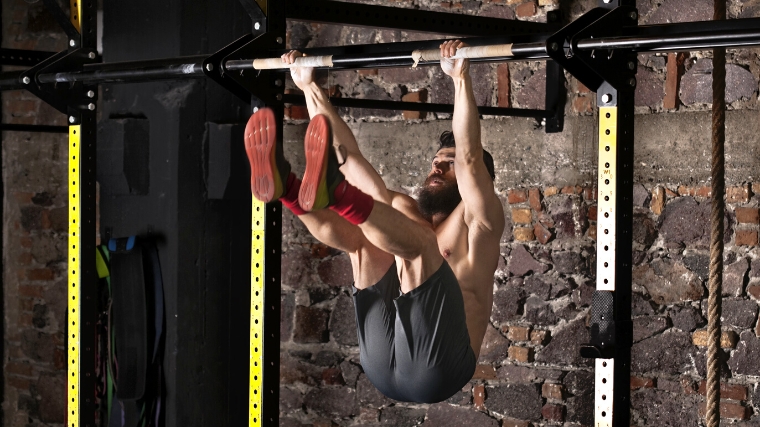
Keep away from it: Throughout upward leg movement, deal with powerfully pulling your knees towards your elbows. If this intent isn’t sufficient, it’s acceptable to take care of a small quantity of flexion all through the upward motion part. Then, on the final doable second, full the motion by reaching your toes to the bar. Athletes who lack the mobility to attain the absolutely compressed place, could profit from the hanging L-sit variation mentioned under.
Slowing the Descent
In distinction to the strict model (and most workouts within the health club), the downward motion part of the kipping toes-to-bar is not supposed to be sluggish and managed. Coming down slowly kills your momentum and extinguishes the stretch reflex — Each of those options are wanted to carry out environment friendly reps in consecutive style.
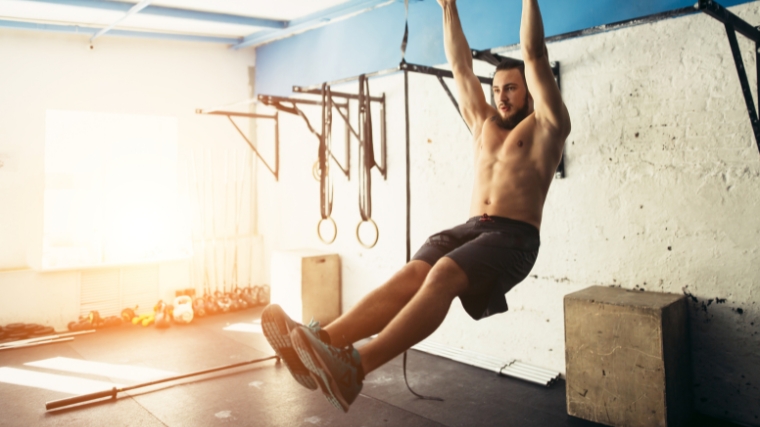
Keep away from it: As a substitute of making an attempt to manage the descent along with your hip flexors and abdominals, actively drive into extension throughout the descent — first out of your hips, then out of your backbone.
The best way to Progress the Toes to Bar
Not like conventional resistance coaching workouts, the toes-to-bar isn’t sometimes progressed through the addition of weight except, in fact, this happens inadvertently after an enormous pre-workout meal. Moderately, the toes-to-bar is appropriately progressed by growing repetition fee, manipulating physique place, and increasing set durations.
Carry out Extra Repetitions Inside a Given Time
In health competitors, the speed of repetition completion is crucial issue, typically aiming to finish as many repetitions as rapidly as doable. Subsequently, pushing your self to finish extra toes-to-bar reps in a set timeframe is a good way to progress this motion. Set a timer for 20 to 40 seconds and hammer out as many good repetitions as doable. Subsequent session, shoot for one or two extra reps in the identical time.
Lengthen Your Legs
Holding a slight bend within the knees throughout the kipping toes-to-bar is appropriate and probably useful as a result of it will increase repetition velocity. For these much less considering competitors and extra considering coaching abdominals and hip flexors, maintaining your knees straight all through the toes-to-bar is an applicable development.
Straight legs place your heart of mass farther from the working muscle mass (your abdominals), thereby growing mechanical demand. To progress on this style, merely hold your knees as straight as doable all through the ahead/upward motion part of the train.
Carry out Extra Repetitions “Unbroken”
In CrossFit vernacular, “unbroken” refers to stringing a number of repetitions collectively with out interruption. If fatigue or lack of coordination forces you to launch the bar between reps, miss a rep, or carry out an additional kip, your set of toes-to-bar is not unbroken. Performing unbroken units builds muscular endurance and taxes coordination.
To progress, merely set up the variety of repetitions you’ll be able to carry out unbroken, then shoot for an additional repetition or two subsequent time.
Advantages of the Toes to Bar
In stark distinction to the advanced motion and coordination calls for of the toes-to-bar, the train requires one easy piece of equipment — a sturdy pull-up bar. Subsequently, the next advantages may be reaped at any health club or native park.
Full Vary of Movement Coaching
The hips and trunk cycle by means of extremes of flexion and extension throughout the toes-to-bar. At these excessive positions, core and hip muscle mass are educated at lengthy muscle lengths. Constant coaching at lengthy muscle lengths could scale back threat of muscle and tendon harm. For instance, Nordic Curls, which practice the hamstrings at lengthy lengths are related to decreased harm threat. (1)
Whereas extra dynamic workouts like toes-to-bar haven’t but been studied for the aim of harm prevention, it’s believable they confer a protecting impact, making the abdominals and hip flexors extra resilient to strains.
Builds Ballistic Core Energy
Belly- and hip flexor muscle mass expertise speedy stretch instantly adopted by contraction throughout the toes-to-bar. This sequence engages a phenomenon referred to as the “stretch-shortening cycle” to supply a robust and environment friendly muscle contraction. Practically all sports activities and athletic endeavors depend on stretch shortening cycle muscle actions. And with coaching, stretch shortening cycle contractions may be enhanced.
So, whether or not you wish to spike an unreturnable volleyball, launch a downfield soccer throw-in, or speed up previous your competitors on the cross-country ski trails, coaching the stretch shortening cycle by means of the toes-to-bar is probably going to assist.
Motion Coordination Coaching
The kipping toes-to-bar calls for sequenced and managed motion of the trunk, hips, and shoulder girdle. Timing is all the pieces, as momentum have to be carried from one physique section to the following. Dialing-in this coordination units the muse for different abilities requiring comparable actions. Gymnasts use toes-to-bar to show a clear kipping approach for mounting above the bar. You may use the toes-to-bar to construct as much as comparable actions, corresponding to kipping muscle-ups, kipping pull-ups, or perhaps even “the worm” (should you’re into breakdancing).
Muscle tissues Labored by Toes to Bar
The toes-to-bar trains muscle mass of the anterior chain — the muscle mass on the entrance of the physique. Muscle tissues of the posterior chain, such because the spinal erectors, multifidi, and hip extensors, assist to drive the physique into the backswing of the kip, however the anterior core predominates.
Abdominals and Hip Flexors
The duties of transitioning from the arched place to the hole place of the kip and driving the toes legs vertical to succeed in to the bar are completed by the abdominals and hip flexors. Key muscle mass embody rectus abdominis, exterior obliques, inside obliques, iliacus, psoas main, and rectus femoris.
Grip and Shoulders
A robust grip and robust shoulders are non-negotiable attributes for the toes-to-bar. Finger flexors and thumb muscle mass should not solely help the burden of the physique, however take care of multidirectional forces produced throughout kipping.
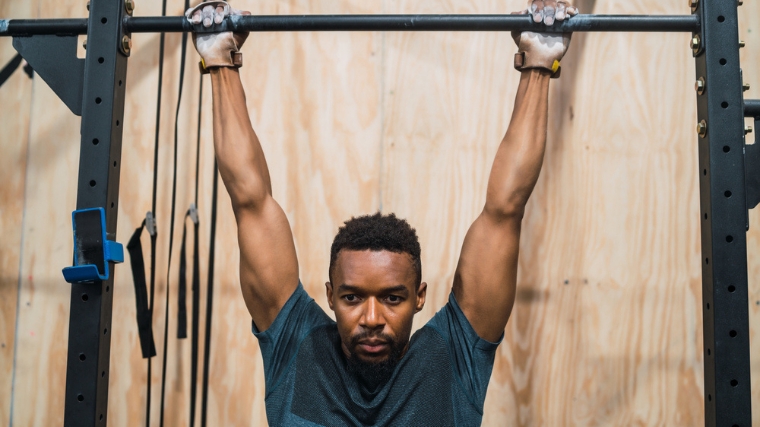
Whereas stabilizing muscle mass protect the integrity of the shoulder, shoulder flexors and extensors rhythmically contract to facilitate kipping. Most notable are latissimus dorsi, areas of pectoralis main, and posterior deltoid, which assist to create the hole place and hold the trunk behind the bar throughout the leg elevate.
The best way to Program the Toes to Bar
The toes-to-bar is more likely to pop up in prescribed CrossFit exercises throughout competitions and coaching. They are often programmed for day-to-day workouts in quite a lot of methods to fit your wants.
A part of a Complicated
A complex is 2 or extra workouts carried out constantly with the identical gear. Complexes are an environment friendly and fascinating option to construct work capability and develop motion abilities. The toes-to-bar pairs effectively with kipping muscle-ups and kipping pull-ups, because the momentum from the kipping movement may be preserved all through the complete advanced. For a problem, attempt six repetitions of toes-to-bar, adopted by three reps of muscle-ups, then six kipping pull-ups.
Progressive Ability Coaching
Devoted follow is required to attain technical mastery of the toes-to-bar. Motor studying is probably going simplest when unfatigued. (2) For greatest outcomes, dedicate an early portion of your workout to the toes-to-bar. Attempt three to 5 units of six to 12 reps, three or extra days per week.
If you’re a CrossFit competitor, you’ll possible must carry out toes-to-bar in a fatigued state. So be sure you problem your self occasionally with longer units, quick relaxation intervals between units, or circuit coaching that features the toes-to-bar.
A part of a Multi-Mode Exercise
Within the sport of health (i.e. CrossFit), a number of workouts are programmed in the identical exercise, typically in circuit coaching style. Generally, these workouts are carried out as “rounds for time” (RFT). In an RFT exercise, a spherical consists of an outlined variety of repetitions for a number of workouts. The athlete performs a chosen variety of rounds as quick as doable. For instance, eight rounds of 16 kettlebell swings, eight toes-to-bar, and 4 wall ball photographs. Monitor the time it takes to finish the complete sequence and purpose to beat that point subsequent exercise.

One other widespread exercise design is EMOM or each minute on the minute. The workouts are carried out for a prescribed variety of repetitions each minute for a chosen variety of minutes. The repetitions needs to be accomplished in underneath one minute, and any time remaining is devoted to relaxation. For fast exercise, attempt a 10-minute EMOM of eight toes-to-bar, six push-ups, and 4 dumbbell front squats.
Toes-to-Bar Variations
Novice athletes or athletes with objectives outdoors of CrossFit, gymnastics, and parkour could also be higher served by one of many following variations.
Strict Toes-to-Bar (Hanging Leg Raises)
These with health objectives circuitously associated to gymnastics or health competitors could take into account the strict toes-to-bar variation, generally referred to as “hanging leg raises.”
By eliminating the momentum and stretch reflex generated by a kip, the strict variation forces your abdominals and hip flexors to behave in a slower and extra remoted style. This ends in larger ranges of muscle exercise within the rectus abdominis and obliques. (3)
Hanging L-Sit
Hanging L-sits are an isometric, or immobile, endurance train. The “L-sit” locations the mass of the legs at its furthest level from the hips and low again, which trains your abdominals and hip flexors. This train could assist to handle weak factors within the toes-to-bar.
In the event you’re not accustomed to coaching your hip flexors at quick muscle lengths, don’t be shocked in the event that they cramp throughout your first few classes. Shake it out and get again to work.
Managed GHD Sit-Ups
To progress towards the kipping toes-to-bar, novice athletes ought to take into account the managed glute-hamstring developer (GHD) sit-up. Not like standard sit-ups on the ground or a sit-up board, this train trains your hip flexors and abdominals at lengthy muscle lengths.
This train will also be used as a development towards CrossFit-style GHD sit-ups, that are carried out extra quickly and with outstretched arms.
Mendacity Leg Lifts
Athletes unable to hold from a pull-up bar attributable to weak point or equipment unavailability may take into account coaching their abdominals and hip flexors utilizing mendacity leg lifts. This train solely requires a bench or open flooring area and a sturdy object to carry on to as a counterbalance to the decrease physique — a heavy kettlebell or dumbbell additionally works.
Be sure you hold your low again pressed into the bench or flooring all through every repetition to keep away from a lack of pressure on the backside of the repetition.
FAQs
The toes-to-bar is a superb belly train for these bodily ready to take care of its calls for. And, sure, it may bias the decrease parts of those muscle mass.
The toes-to-bar entails resisted and highly effective trunk flexion, which undoubtedly works the abdominals. Rectus abdominis (the “six-pack abs” muscle) runs vertically from the underside of the sternum and ribcage to the pubic bone. The fibers of rectus abdominis additionally run vertically however don’t run the complete size of rectus abdominis, as a result of they’re interrupted by tendinous inscriptions that create the define of a chiseled six- (or eight-) pack.
As a result of momentum of the kip and the stretched place of the muscle, rectus abdominis possible experiences peak pressure throughout the speedy eccentric contraction on the backside of the motion. Eccentric muscle contractions have been proven to elicit preferentially better muscle progress on the distal finish of the muscle in different physique components. (4) Subsequently, the eccentric bias of the toes-to-bar may, theoretically, result in enhanced decrease belly improvement over time.
A rationale based mostly on floor electromyography (sEMG) is mostly cited to help the toes-to-bar (and comparable workouts) for “decrease abs” coaching. Leg raises end in better exercise within the decrease portion of rectus abdominis than the higher parts. (5) Related findings have been reported with hanging knee-ups, that are primarily hanging leg raises carried out with bent legs. (6) As a result of similarities between these workouts and the toes-to-bar, it’s pretty protected to imagine that the toes-to-bar, too, electromyographically biases the decrease rectus abdominis.
Nevertheless, floor electromyography isn’t a sound indicator of the quantity of muscle a dynamic train prompts or will finally stimulate to develop. (7)(8) For these causes, we have to be cautious about inferring superior “decrease ab” hypertrophy outcomes from toes-to-bar.
Remember, toes-to-bar is a really quick motion. Though peak pressure within the muscle is probably going fairly excessive throughout the eccentric transition of the kip, the abdominals don’t expertise extended time underneath pressure. These interested in building muscle could also be higher served by a extra conventional train variation, such because the strict toes-to-bar or reverse crunch.
Hanging ab straps can be utilized throughout the strict toes-to-bar to scale back demand on the shoulders and grip. Gymnastics grips or chalk could help with grip points. Apart from these modifications, it is likely to be prudent to deal with building your forearms and lats to work as much as the toes-to-bar. Pull-ups and lat pulldowns are nice choices.
Think about a progressive technique to construct the requisite power and management for toes-to-bar repetitions. Here’s a pattern train development utilizing Variations mentioned above: Begin by coaching your hip flexors and abdominals at quick muscle lengths utilizing hanging L-sits. Add lengthy muscle size work through managed GHD sit-ups.
Strict toes-to-bar, though tough, could also be doable earlier than kipping toes-to-bar, as a result of they’re much less advanced. Apply the ahead and again (arch to hole) kipping movement, in isolation with out the leg elevate, on a pull-up bar. As soon as proficient, it’s time for the real-deal toes-to-bar.
Appropriated by CrossFit, however Not Restricted to “Health Competitions”
The toes-to-bar is a comparatively advanced train utilized in some CrossFit competitions and exercises. It will also be used to develop gymnastics abilities, be positioned in calisthenics applications, or it may be added added to an ordinary health club exercise as a novel core train.
Like several advanced train, mastery of the toes-to-bar takes follow and endurance. However when you dial in, you’ll be stringing collectively unbroken repetitions with ease with core power, and core improvement, to point out for it.
References
- Al Attar, W. S. A., et al. (2017). Impact of harm prevention applications that embody the Nordic hamstring train on hamstring harm charges in soccer gamers: a scientific overview and meta-analysis. Sports activities Medication, 47, 907-916.
- Branscheidt, M., et al. (2019). Fatigue induces long-lasting detrimental modifications in motor-skill studying. Elife, 8, e40578.
- McGill, S., Andersen, J., & Cannon, J. (2015). Muscle exercise and backbone load throughout anterior chain entire physique linkage workouts: the physique noticed, hanging leg elevate and walkout from a push-up. Journal of Sports activities Sciences, 33(4), 419-426.
- Franchi, M. V., Reeves, N. D., & Narici, M. V. (2017). Skeletal muscle transforming in response to eccentric vs. concentric loading: morphological, molecular, and metabolic diversifications. Frontiers in Physiology, 8, 447.
- Pruthviraj, R., & Paul Daniel, V. Ok. (2017). Electromyographic evaluation of workouts proposed for differential activation of rectus abdominis muscle parts. Int J Phys Educ Sports activities Well being, 4, 153-157.
- Escamilla, R.F, et al. (2006). Electromyographic Evaluation of Conventional and Nontraditional Belly Workout routines: Implications for Rehabilitation and Coaching. Bodily Remedy, 86(5), 656–671.
- Vigotsky, A. D., et al. (2018). Deciphering sign amplitudes in floor electromyography research in sport and rehabilitation sciences. Frontiers in Physiology, 985.
- Vigotsky, A. D., et al. (2017). Larger electromyographic responses don’t indicate better motor unit recruitment and ‘hypertrophic potential’ can’t be inferred. The Journal of Power & Conditioning Analysis, 31(1), e1-e4.
Featured Picture: MilanMarkovic78 / Shutterstock
Trending Merchandise

FITINDEX Vibrating Foam Roller 5-Speed, Next Generation Electric Foam Roller for Muscle Relax, Fitness Deep Massage Foam…

Resistance Bands for Working Out with Exercise Guide. Fabric Booty Bands for Women Men. Workout Bands Leg Bands for…

GAODI Women Waist Trainer Vest Workout Slim Corset Neoprene Sauna Tank Top Zipper Weight Loss Body Shaper

FITNE Green Tea Herbal Honey Lemon With Garcinia Senna Infusion Gentle Detox Cleanse High Antioxidant No Calories Stevia…

FITNE Black Currant Herbal Green Tea Fruity Garcinia Senna Infusion Gentle Detox Cleansing Boost Antioxidant Wellness…










